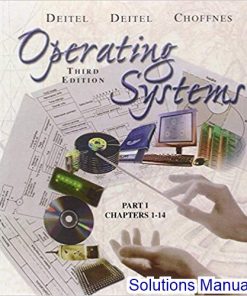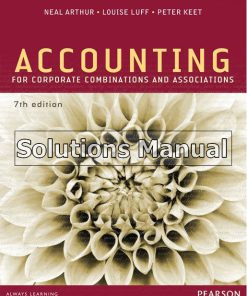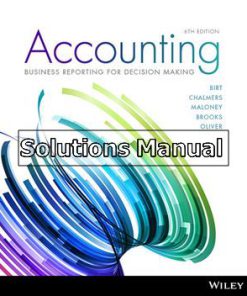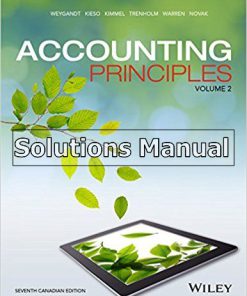$26.50$50.00 (-47%)
In stock
Operating Systems Internals and Design Principles 9th Edition Stallings Solutions Manual.
You may also like
Instant download Operating Systems Internals and Design Principles 9th Edition Stallings Solutions Manual pdf docx epub after payment.

Product Details:
- ISBN-10 : 0134670957
- ISBN-13 : 978-0134670959
- Author: William Stallings (Author)
Now in its 9th Edition, Operating Systems: Internals and Design Principles provides a comprehensive, unified introduction to operating systems topics for readers studying computer science, computer engineering, and electrical engineering. Author William Stallings emphasizes both design issues and fundamental principles in contemporary systems, while providing readers with a solid understanding of the key structures and mechanisms of operating systems. He discusses design trade-offs and the practical decisions affecting design, performance and security. The text illustrates and reinforces design concepts, tying them to real-world design choices with case studies in Linux, UNIX, Android, and Windows 10.
With an unparalleled degree of support for project integration, plus comprehensive coverage of the latest trends and developments in operating systems, including cloud computing and the Internet of Things (IoT), the text provides everything readers need to keep pace with a complex and rapidly changing field. The 9th Edition has been extensively revised and contains new material, new projects, and updated chapters.
Table of contents:
- Online Chapters and Appendices
- VideoNotes
- Preface
- About the Author
I. Background
- Computer System Overview
- 1.1. Basic Elements
- 1.2. Evolution of the Microprocessor
- 1.3. Instruction Execution
- 1.4. Interrupts
- 1.5. The Memory Hierarchy
- 1.6. Cache Memory
- 1.7. Direct Memory Access
- 1.8. Multiprocessor and Multicore Organization
- 1.9. Key Terms, Review Questions, and Problems
- 1A. Performance Characteristics of Two-Level Memories
- Operating System Overview
- 2.1. Operating System Objectives and Functions
- 2.2. The Evolution of Operating Systems
- 2.3. Major Achievements
- 2.4. Developments Leading to Modern Operating Systems
- 2.5. Fault Tolerance
- 2.6. Os Design Considerations for Multiprocessor and Multicore
- 2.7. Microsoft Windows Overview
- 2.8. Traditional Unix Systems
- 2.9. Modern Unix Systems
- 2.10. Linux
- 2.11. Android
- 2.12. Key Terms, Review Questions, and Problems
II. Processes
- Process Description and Control
- 3.1. What is a Process?
- 3.2. Process States
- 3.3. Process Description
- 3.4. Process Control
- 3.5. Execution of the Operating System
- 3.6. Unix Svr4 Process Management
- 3.7. Summary
- 3.8. Key Terms, Review Questions, and Problems
- Threads
- 4.1. Processes and Threads
- 4.2. Types of Threads
- 4.3. Multicore and Multithreading
- 4.4. Windows Process and Thread Management
- 4.5. Solaris Thread and Smp Management
- 4.6. Linux Process and Thread Management
- 4.7. Android Process and Thread Management
- 4.8. Mac OS X Grand Central Dispatch
- 4.9. Summary
- 4.10. Key Terms, Review Questions, and Problems
- Concurrency: Mutual Exclusion and Synchronization
- 5.1. Mutual Exclusion: Software Approaches
- 5.2. Principles of Concurrency
- 5.3. Mutual Exclusion: Hardware Support
- 5.4. Semaphores
- 5.5. Monitors
- 5.6. Message Passing
- 5.7. Readers/Writers Problem
- 5.8. Summary
- 5.9. Key Terms, Review Questions, and Problems
- Concurrency: Deadlock and Starvation
- 6.1. Principles of Deadlock
- 6.2. Deadlock Prevention
- 6.3. Deadlock Avoidance
- 6.4. Deadlock Detection
- 6.5. An Integrated Deadlock Strategy
- 6.6. Dining Philosophers Problem
- 6.7. Unix Concurrency Mechanisms
- 6.8. Linux Kernel Concurrency Mechanisms
- 6.9. Solaris Thread Synchronization Primitives
- 6.10. Windows Concurrency Mechanisms
- 6.11. Android Interprocess Communication
- 6.12. Summary
- 6.13. Key Terms, Review Questions, and Problems
III. Memory
- Memory Management
- 7.1. Memory Management Requirements
- 7.2. Memory Partitioning
- 7.3. Paging
- 7.4. Segmentation
- 7.5. Summary
- 7.6. Key Terms, Review Questions, and Problems
- 7A. Loading and Linking
- Virtual Memory
- 8.1. Hardware and Control Structures
- 8.2. Operating System Software
- 8.3. Unix and Solaris Memory Management
- 8.4. Linux Memory Management
- 8.5. Windows Memory Management
- 8.6. Android Memory Management
- 8.7. Summary
- 8.8. Key Terms, Review Questions, and Problems
IV. Scheduling
- Uniprocessor Scheduling
- 9.1. Types of Processor Scheduling
- 9.2. Scheduling Algorithms
- 9.3. Traditional Unix Scheduling
- 9.4. Summary
- 9.5. Key Terms, Review Questions, and Problems
- Multiprocessor, Multicore, and Real-Time Scheduling
- 10.1. Multiprocessor and Multicore Scheduling
- 10.2. Real-Time Scheduling
- 10.3. Linux Scheduling
- 10.4. Unix Svr4 Scheduling
- 10.5. Unix Freebsd Scheduling
- 10.6. Windows Scheduling
- 10.7. Summary
- 10.8. Key Terms, Review Questions, and Problems
V. Input/Output and Files
- I/O Management and Disk Scheduling
- 11.1. I/O Devices
- 11.2. Organization of the I/O Function
- 11.3. Operating System Design Issues
- 11.4. I/O Buffering
- 11.5. Disk Scheduling
- 11.6. Raid
- 11.7. Disk Cache
- 11.8. Unix Svr4 I/O
- 11.9. Linux I/O
- 11.10. Windows I/O
- 11.11. Summary
- 11.12. Key Terms, Review Questions, and Problems
- File Management
- 12.1. Overview
- 12.2. File Organization and Access
- 12.3. B-Trees
- 12.4. File Directories
- 12.5. File Sharing
- 12.6. Record Blocking
- 12.7. Secondary Storage Management
- 12.8. Unix File Management
- 12.9. Linux Virtual File System
- 12.10. Windows File System
- 12.11. Android File Management
- 12.12. Summary
- 12.13. Key Terms, Review Questions, and Problems
VI. Embedded Systems
- Embedded Operating Systems
- 13.1. Embedded Systems
- 13.2. Characteristics of Embedded Operating Systems
- 13.3. Embedded Linux
- 13.4. Tinyos
- 13.5. Key Terms, Review Questions, and Problems
- Virtual Machines
- 14.1. Virtual Machine Concepts
- 14.2. Hypervisors
- 14.3. Container Virtualization
- 14.4. Processor Issues
- 14.5. Memory Management
- 14.6. I/O Management
- 14.7. Vmware Esxi
- 14.8. Microsoft Hyper-V and Xen Variants
- 14.9. Java Vm
- 14.10. Linux Vserver Virtual Machine Architecture
- 14.11. Summary
- 14.12. Key Terms, Review Questions, and Problems
- Operating System Security
- 15.1. Intruders and Malicious Software
- 15.2. Buffer Overflow
- 15.3. Access Control
- 15.4. Unix Access Control
- 15.5. Operating Systems Hardening
- 15.6. Security Maintenance
- 15.7. Windows Security
- 15.8. Summary
- 15.9. Key Terms, Review Questions, and Problems
- Cloud and IoT Operating Systems
- 16.1. Cloud Computing
- 16.2. Cloud Operating Systems
- 16.3. The Internet of Things
- 16.4. IoT Operating Systems
- 16.5. Key Terms and Review Questions
Appendix A. Topics in Concurrency
Appendix B. Programming and Operating System Projects
References
Credits
Index
People also search:
Operating Systems Internals and Design Principles 9th Edition
Operating Systems Internals and Design Principles 9th Edition pdf
Operating Systems Internals and Design Principles
7 function of operating system
william stallings operating systems internals and design principles












